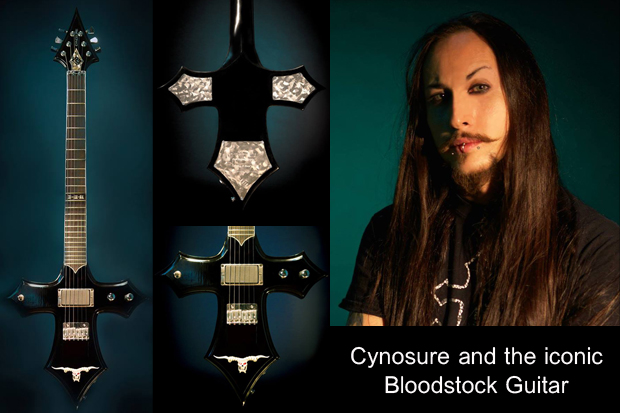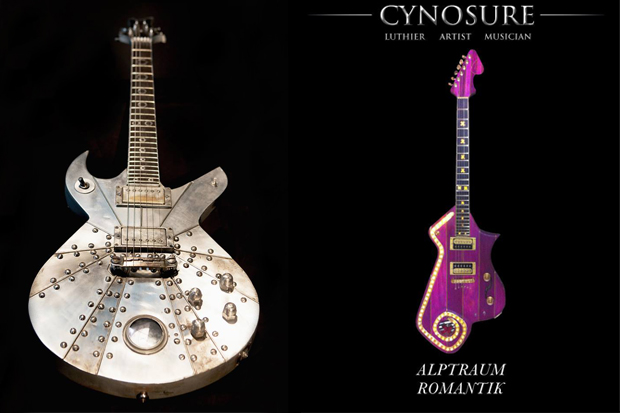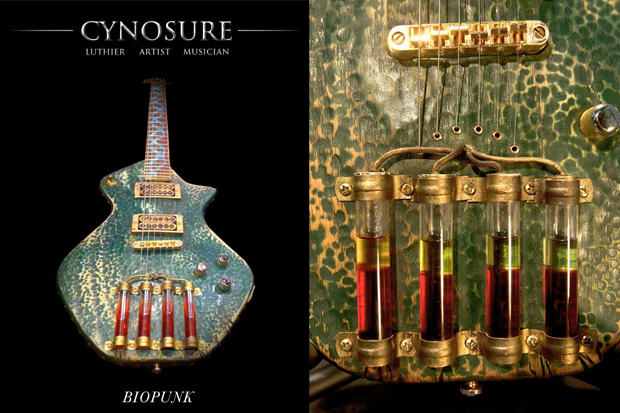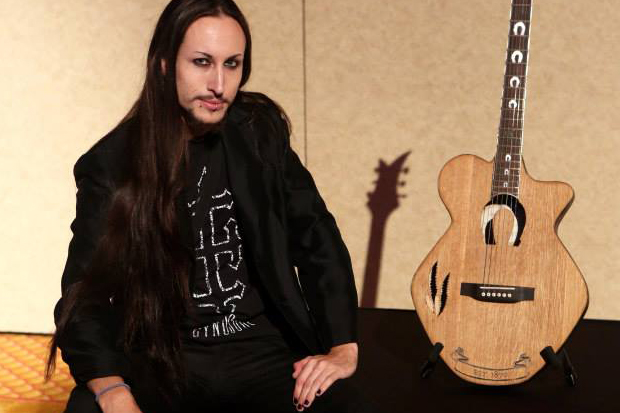Interviews
Interview with Cynosure; Creator of Cynosure Guitars Discusses Custom Guitars, Basses and More
Cynosure extensively talks about his origins and creative process, plus what it means to be an artist that puts his heart and soul into each of his one-of-a-kind instruments.

Being able to make a awesome-sounding guitar can be considered a lifetime achievement for any guitar builder. If, on top of that, each guitar is custom-made with memorable visual attributes, then there’s no doubt: you’re a master artist or at least, you’re on the way to becoming one. That’s the case of Cynosure—whose guitars go by the same moniker. This young British artisan is part of that now-rare (some would say “dying”) breed of instrument builders that give each of their creations a unique sound and design. In this interview Cynosure extensively talks about his origins and creative process, plus what it means to be an artist that puts his heart and soul into each of his one-of-a-kind instruments.
Where does the name Cynosure Guitars come from?
Cynosure: I happened upon the word ‘cynosure’ a few years ago whilst looking up another word in the dictionary. The word intrigued me as it sounded particularly unique and mysterious; after understanding its meaning and definition, I wanted to adopt it to represent myself as an artist as well as for my art creations. ‘Cynosure’ can be defined as “…something that attracts attention by its brilliance….”

Most people that build musical instruments can also play them. Is that your case?
Cynosure: I think in order to build instruments you at least have to have a basic ability and proficiency in playing the instrument. I don’t understand how you can know the mechanism of the instrument without actually engaging it, musically.
When and how did you start to learn the craft of building guitars?
Cynosure: I initially consulted YouTube primarily as a source of instruction, perusing guitar-building videos and acknowledging guitar forums (I now think guitar forums are totally egregious and a waste of time due to incorrect information, guess work and subjectivity); however, it was through YouTube videos that I learnt certain procedures from. The “craft” is an alchemical process and NOTHING is absolute. I wanted to start building guitars about 3 years ago as I set-out redefine the guitar as an instrument, break down the conception of a guitar to its most basic form, and build with that mentality. I spent about 8 months researching information, techniques, woods, tools, practices before designing and building my first guitar. Even now, the design process is as fundamental in time as the building process. The guitar exists on paper before the chisel carves the wood. The idea was to create a guitar that would be multi-faceted, an art-piece that would be recognized as such, however, still maintaining its distinction as a playable instrument.

At what point during your learning process did you feel ready to start taking commissions for custom-made guitars?
Cynosure: After one year I had built 3 guitars that I had personally financed, built on a leisurely basis. After promoting my work online, I garnered a small following and reputation as a very unique guitar-builder. It was around this time that I was contacted by a tequila company looking to promote their brand by utilizing a very unique product that represented them. My first commission became my first acoustic guitar creation. Herradura Tequila was the name of the company that had given me this opportunity. I asked them to send me a barrel as I had designed a product that would capture the essence of Mexico, and what better way than to actually implement their product (or vessel of the product) into the work itself. The guitar was conceived upon a variety of inspirations directly taken out of Mexico, the Mexican jug, the herradura ʻhorseshoeʼ, the agave leaf and perhaps most prominently, the ʻMariachiʼ-style guitar. the reverse of the guitar featured an arched back complete with a Map of Mexico highlighting the specific location where the famous tequila was made.
Can you mention some of your clients?
Cynosure: Some of my clients include Bloodstock owner/director, paul Raymond Gregory, cirque-troupe CircX, liquor brands Herradura Tequila, Jack Daniels, U.S. Navy, Navy SEALS Foundation, F*ck Cancer Foundation and Iʼm currently working out some logistics with some well-known guitarists.

Each of your guitars follow certain specifications. Do you sometimes find it challenging to follow some of your clients request?
Cynosure: Things that may be related to materials, shapes and other particularities that could affect the instrumentʼs successful performance?Well, as aforementioned, I work out the specifications (and how they will affect the infrastructure of the instrument itself) during the design process. For example, I am currently working on an exceptionally custom guitar for renowned artist, Paul Raymond Gregory, Itʼs like a sculpture that functions as a guitar; the design is so specific that in fact, my first thoughts were that it would be almost impossible to play as a regular instrument. the design, as a concept, had to be slightly altered to allow for the player to perform its primary function. Visually, the guitar is a human skull with protruding rams horns, all of which are carved from the same piece of wood.
As you can imagine, such a creation may impede functionality, however, that is what consultation is for. I work with the client to ʻiron outʼ all the restrictions and encumbrances that a design may pose, so that the guitar can function to its best possible optimum. Generally speaking, materials do not pose a problem, at least not yet. Iʼm known for implementing rather unorthodox materials and technology into my guitars, though, somewhere down the line, Iʼm sure a client may require an endangered wood species – problem there – or they may ask me to build something totally perplexing…like a marble guitar, I donʼt know, but I will always take on new challenges and create the instruments other luthiers are afraid to do themselves.
You build both electric and acoustic guitars. Is there any particular difference in the way you approach the creation of each of these?
Cynosure: Interesting question. the approach is very different in terms of construction. I certainly prefer the methodology of electric guitars, perhaps because of its allowance to ʻbreak the rulesʼ. Essentially, electric guitars can be made from a whole compendium of materials, also, they have more resistance to conformity. Obviously, the main distinction between an electric guitar and an acoustic are its principles in producing sound. An electric guitar relies on its pickups -transforming oscillating vibrations into sound waves, whilst an acoustic requires an ʻemptyʼ chamber to allow sound waves to rebound and resonate against the chamber walls. Certain materials differ, but the method of construction is perhaps the most prodigious variance, whilst an acoustic guitar features ultra-thin walls to enhance tone. An electric guitar will mostly be entirely solid, as they work on a different set of principles.

Could you describe the creative process of building one of these instruments, for example, the original Bloodstock guitar?
Cynosure: The lengthy part of the creative process is of course, the concept. I am renowned for implementing a distinction on metaphor within my work as i feel that the thematic should be carried throughout the entire guitar, whether that be in regards to its shape, features, technology or otherwise. For example, the Bloodstock guitar was created rather specifically within the nature of its concept. I wanted to embody the dynamics of the festival as as singular object; something that represented the institution of Rock and Metal music, yet still pay attention to unequivocal individuality. it was this decision that governed the body shape: an inverted cross. A rather daring and provocative idea which fulfilled the very notion of power, rebellion and individuality (essentially the ethos of Rock and Metal music).
Cynosure Guitars are not merely instruments of functionality, but more of an aberration, a departure of normality and enter the realm of surrealism. I want my guitars to reflect the ʻpersonalityʼ of the client so that each guitar has its own identity and idiosyncrasies. Each guitar is a symbol that evokes characteristics of a thematic or subject. The design process may take as long as the time needed to create that entity, physically. On average, perhaps a time-frame of 4-6 weeks building time is expected for a Cynosure Guitar. Iʼm often inspired by technology, history, literature, philosophy, nature and industry as a formulate perspective that is cohesive within all my guitars. I like to experiment with materials, designs and methods to produce unique art-pieces that serve as instruments. For me, guitar-building is an alchemical process, there is no right or wrong…as a luthier, you are the typewriter behind the book, the camera behind the film.
What, in your opinion, is the key to maintaining the right balance between the visual and technological aspects of each of the guitars that you create?
Cynosure: Always, and inevitably, function is first. My creations are conceived directly around the functionality of the instrument, that is its purpose. I try and distance myself from traditional thought-processes and designs as there is so much yet to be discovered. A modernist would say “form follows function,” though, I challenge that. The basic principles of a guitar are the same – (electric) humbucker, body, strings, everything else is subjective and open to interpretation. Once you establish the logistics behind the acoustics, the rest is dependent on your imagination.

Is there any particular guitar that you feel the most proud of?
Cynosure: I am most proud of the Bloodstock guitar for a number of reasons. It is substantially unique… you could never purchase something like this in a regular guitar store, it would have to be entirely custom-made, specifically. The design itself is very powerful, it serves as an instrument but also a dominant statement, an impacting figure-head that raises questions and refuses to be anything but striking. The Bloodstock guitar incorporates 2 red L.E.D.s that assume the eyes behind the carved “Bloodstock Ram” emblem situated beneath the hard tail bridge. The guitar, built for Paul Raymond Gregory, has been played by bands such as, Carcass, Emperor, Crowbar and Dave Mustaine of Megadeth.
Given that these instruments are custom-made, I imagine that their price might not be affordable for everyone. Is that the case?
Cynosure: My pricing starts at $2,500 for a full custom, so, I guess not everybody can afford them, however, my guitars are not meant for everybody. i have a unique platform and my price reflects my individual approach to guitars. I do not aim to please, as I think if you conciliate everybody, you can become nothing more than mediocre. Also, my guitars are fully-custom made so they are priced accordingly to the time and effort involved. Perhaps in the future I will automate my designs, then, I could sell them for less. But, for now, whilst each guitar is an individual, the price reflects the time, effort, skill and craftsmanship involved.
Check out Biohazard admiring the Infernus Guitar at Bloodstock Festival.
Because of the artistry featured on your creations, you were invited to exhibit your work on the Rock and Metal Gallery of the 2014 edition of the Bloodstock Festival. How was that experience and what kind of feedback did you receive there?
Cynosure: Bloodstock 2014 was the biggest audience I have ever experienced to date. i was invited by Founder/Director, Paul Raymond Gregory as he felt as though we both had something in common, “fantasy.” Paul is a distinguished and sought-after artist, having worked with bands such as Ronnie James Dio, Iron Maiden, Saxon, just to name a few. He appreciated my postmodern approach to visualization of the instruments and requested that I showcase my “fantastical” instruments among his artwork. The whole experience was most humbling, having some of my favorite artists and bands take notice of my art, not only offering their opinions, but expressing genuine admiration for my work.
You’re a true artisan, a rare kind of artist that is practically extinct today. Do you really feel that there’s still a niche for artists like you in this world of mass-produced instruments?
Cynosure: I believe that there is a market and audience for everything. As technology evolves, craftsmanship decimates. Fortunately, there are enough artists out there to appreciate the “craft” which keeps people like me in business. You get what you pay for. If you are starting out, then a $200 guitar at the local music store is just what you need. However, if you are a serious player you may want an instrument that features finer, more exotic and resonant woods that will ultimately result in a richer-sounding guitar. If you want a full custom, we would consult on the best materials for the design, but also, it can be calibrated to your every need, from a choice of scale lengths, number of strings, design, materials, neck shape, technology, etc. I believe that my work will be highly sought-after as long as there are serious guitar players. Mass-produced guitars loose their individuality and lustre, however I think at some point, I would want to automate production, but still maintain my “signature” approach to individuality.
-

 Music4 days ago
Music4 days agoTake That (w/ Olly Murs) Kick Off Four-Night Leeds Stint with Hit-Laden Spectacular [Photos]
-

 Alternative/Rock5 days ago
Alternative/Rock5 days agoThe V13 Fix #010 w/ High on Fire, NOFX, My Dying Bride and more
-

 Hardcore/Punk2 weeks ago
Hardcore/Punk2 weeks agoHastings Beat Punks Kid Kapichi Vent Their Frustrations at Leeds Beckett University [Photos]
-

 Culture2 weeks ago
Culture2 weeks agoCirque Du Soleil OVO Takes Leeds Fans on a Unique, Unforgettable Journey [Photos]
-

 Alternative/Rock2 weeks ago
Alternative/Rock2 weeks agoA Rejuvenated Dream State are ‘Still Dreaming’ as They Bounce Into Manchester YES [Photos]
-

 Features4 days ago
Features4 days agoTour Diary: Gen & The Degenerates Party Their Way Across America
-

 Culture7 days ago
Culture7 days agoDan Carter & George Miller Chat Foodinati Live, Heavy Metal Charities and Pre-Gig Meals
-

 Music6 days ago
Music6 days agoReclusive Producer Stumbleine Premieres Beat-Driven New Single “Cinderhaze”












